What Covid Containment Has Done to Our Children
For the past two years, what Western governments have done to the next generation — all in the name of keeping them safe, of course — has been calamitous. Instead of trying to ameliorate problems for our children that were already clear, well-documented and steadily worsening over time, in March 2020 the authorities began to perform particularly gruesome social experiments on them. What kind of generation will result?
Anxious and depressed?
Before 2020, anxiety and depression in the young were already on the rise, with a 2018 study finding a 15% increase in unhappiness measures since 2015 for 15-year-olds in the UK, a 10% increase in the US, and a 5% increase in the rich OECD countries as a whole. Substance abuse among teenagers, gaming addiction and other worrying signs were also flashing red in the decade leading up to 2020. Then in 2020 came lockdowns, social distancing, school closures, forced masking, forced vaccination and relentless propaganda.
A 2021 Lancet paper gives us a grim picture of the result, based on data from 204 countries. The key finding was a spectacular increase of more than 25% in both anxiety and depression disorders. As the following graphs show, those just entering adulthood (ages 15-25) and women were the hardest hit.

Now, the data upon which these numbers are based are not the best. They suffer from changes in survey mode over time, a very stringent measure of depression, and other shortcomings. Moreover, the graphs lump together data published through the end of January 2021, so it’s possible that their upward spikes reflect only the temporary effect of the initial panic in early 2020.
So let’s focus now on the highest-quality numbers that show changes across time in the best-studied countries. A good representation of this subgroup is the Netherlands, a country long known for particularly happy teenagers and young adults.
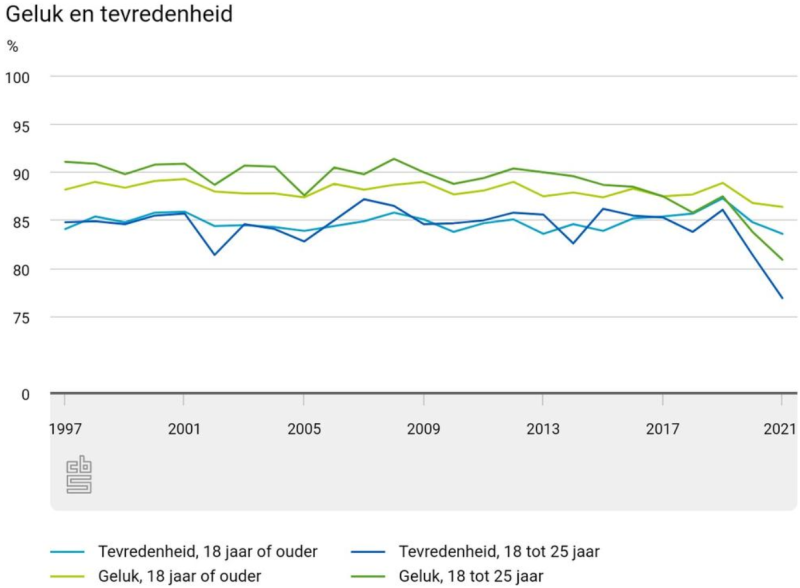
For those who can’t read Dutch, the important lines here are the dark blue one representing life satisfaction for those between ages 18 and 25, and the dark green one representing happiness in the moment for the same age group. The lighter-coloured lines are for everyone above age 18, i.e., the entire adult Dutch population.
Both metrics declined slightly after 2012 for those 18 to 25, hit a local peak in 2019, and then sharply dropped off in 2020, with the dropoff continuing at effectively the same rate in 2021. Life satisfaction levels plummeted by almost 10 percentage points between 2019 and 2021. This is equivalent to a near-doubling of serious depression rates, which is consistent with what we see in the UK and the US for teenagers, where around a third of teens surveyed during lockdowns reported being unhappy or ‘depressed’ (using the everyday rather than the clinical definition of that term).
A similar pattern is seen in other high-quality data for locked-down Western countries, such as that drawn from established longitudinal studies in the UK and Australia.
In sum, an alarming number of our children are now suffering anxiety and depression, with things getting worse as lockdowns continue. That’s not good, you say, but is that the only bad news? People will get over depression, and so the damage will be short-lived, right? Unfortunately not.
Obese and dull-witted?
According to a late-2021 Lancet study, childhood obesity had increased 50% in the UK over the previous year’s numbers. The UK data below shows how weight measures tracked over time in a particular cohort of children:
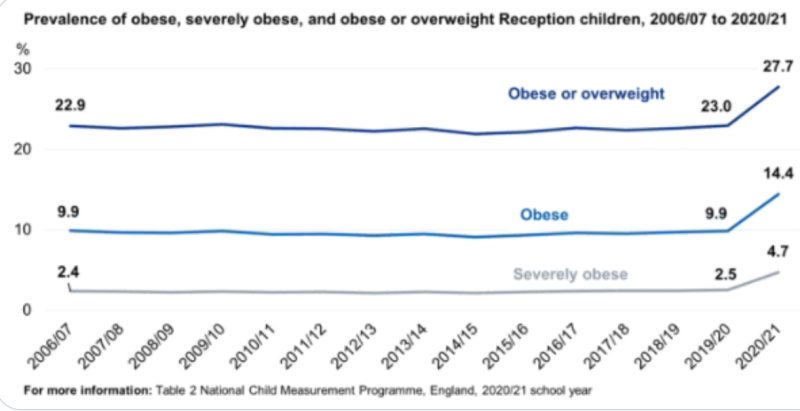
Severe obesity in the UK nearly doubled during the lockdown years, and all overweight categories bulged alarmingly. The data and the pictures are less clean for the US, but the overall message is the same there too. As a recent study from the CDC reported, among 2-to-19-year-olds, the rate of BMI increase roughly doubled during the pandemic. In addition: “Compared with other age groups, children aged 6–11 years experienced the largest increase in their rate of BMI change (0.09 kg/m2/month), with a pandemic rate of change that was 2.50 times as high as the pre-pandemic rate.” Institutionalised poor health advice from our public health ‘experts’ — “stay home, don’t socialise” — turned our kids into blobs.
Thanks to their much-touted “resilience,” might one hope that children can get over a bout of depression, and lose a few pounds, as the cause of the problems recedes? This is a wildly optimistic hope, particularly considering how ineffectual the policies aimed at fighting childhood obesity have been so far.
That’s their bodies, but what about our kids’ brains? IQ and cognitive functioning develop based on investments in early life and are then generally thought to recede beyond early adulthood. What do we see as the harvest of covid mania for our kids in this area?
Researchers already knew the West was in big trouble on this score before the pandemic, with the best data coming from a study of army conscripts in Norway and showing a 5-point IQ drop between the cohort born in 1975 and the one born in 1990 (see panel C on the far right below), with the drop after 1975 undoing the gains made after WWII.
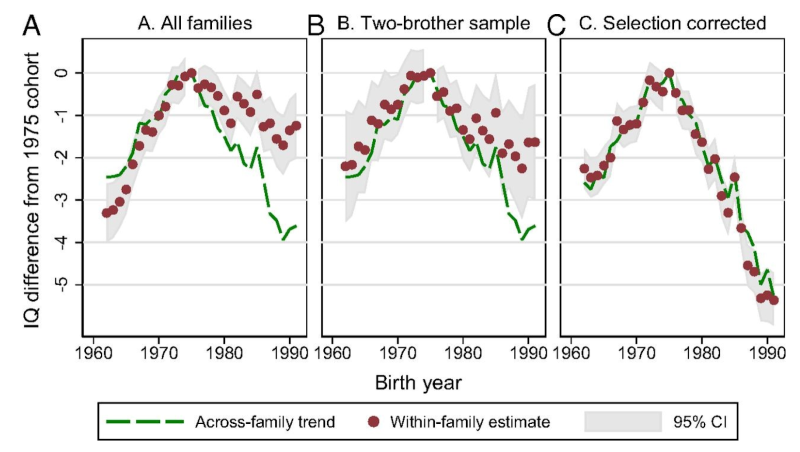
The graphs to the left, incidentally, show a lower decline because of changes over time in the average intelligence of people volunteering for the army. To recover a picture most representative of the whole population, the study compared brothers from the same family (panel B) and then also corrected in each time period for the rate of observed cognitive problems in army conscripts relative to the population as a whole (panel C).
The finding of a large IQ drop pre-2010 holds also for the UK and the US. While we don’t know why for sure, the front-running explanation is that this decline is the product of the mental distractions introduced into society by mobile phones and the internet, which have increasingly damaged the ability of their users to focus and to hold complex abstractions in their heads. Thinking hard has become passé.
What about the 10 years leading up until 2020? Again, probably the most useful comparative data comes from the UK because, unlike many other countries, it did not manipulate its results by fiddling with the schools and groups of students included in the international PISA study. The PISA tests 15-year-olds over time in language, math and science. A key result is the decline in the achievement of the top 10% – the crème de la crème, scoring above the 90th percentile – as shown in the graph of science scores below.
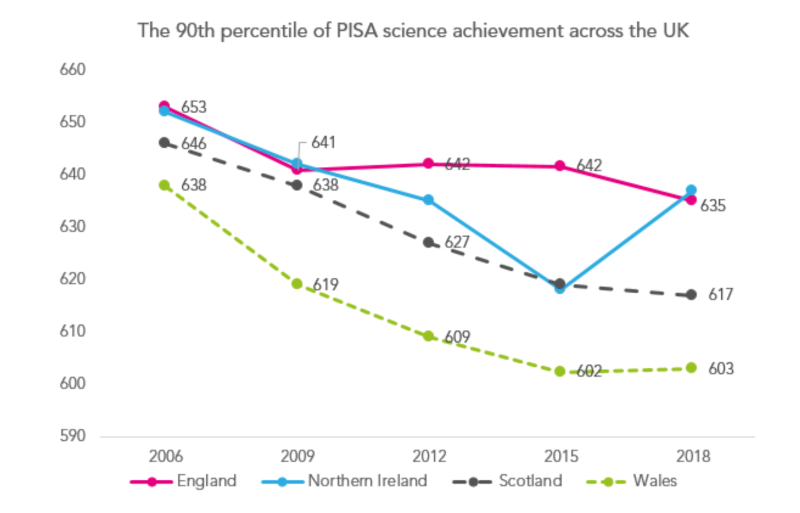
This is another flavour of what we saw above for Norway: a continued dumbing down in the ability to think scientifically, this time affecting the top of the ability range, demonstrating that the drop is not ‘just’ a phenomenon amongst the initially disadvantaged.
Already in the lead-up to 2020 then, fewer and fewer teenagers were scoring impressively on tests of mental ability. A front-running explanation was that social media and the internet were distracting them away from what is needed to build intelligence. You might think that a key lesson would be to keep kids off mobile and electronic devices. Yet, what do we know schools were forced to do during lockdowns? What will have happened in 2020-2022?
The next graph uses data reported by Nature from Rhode Island — a state deeply enamoured of lockdowns — to show what has happened to the mental ability of very young children (3 months to 3 years old) between 2011 and 2021.

This chilling graph shows an almost 20-point drop in what is designed to be roughly equivalent to IQ, representing a reversion to levels of a century ago, and achieved in just two years of inflicting masking and social distancing on our kids, leaving them nothing but the internet for company. Children at this tender age learn things that they cannot learn later, such as early language recognition aided by watching and interacting with whole people showing their full faces.
Data like this suggests that two years of covid madness has inflicted severe, long-term damage on our children.
Unfortunately, this kind of finding is consistent with dozens of other studies from around the world, including a recent report for the Brownstone Institute showing how school closures depressed math proficiency among middle-schoolers in a wealthy US county.
What is the consensus view on the effects of school closures, implemented by rich and poor countries alike during covid times, often for a year or more? A recent literature review concludes:
“In sum, there is clear evidence for a negative effect of COVID-19-related school closures on student achievement. … the effects achieved by remote learning were similar to those achieved when no teaching was implemented at all during summer vacation. Alarmingly, specifically younger children (Tomasik et al., 2020) and children from families with a low SES (Maldonado and De Witte, 2020; Engzell et al., 2021) were negatively affected by COVID-19-related school closures.”
From this we may infer that a year of school closures is effectively a year of education lost, at least for children from poor backgrounds. That is on top of the large IQ declines already occurring before 2020. The data are consistent with the rise of a generation of permanently cognitively damaged children.
Can it get worse than this – a generation depressed, anxious, obese, and operating at cognitive levels thought to be long extinct? We are afraid it can get much worse.
Woke snowflakes?
It has been a long-standing trope within ‘conservative’ circles that the Western world is self-destructing ideologically, finding fault with its own history (shame on the West for centuries of colonialism! And for its Patriarchy! And Transphobia! And Climate Terrorism!). Its cultural traditions, such as Christmas and capitalism, along with its traditional beliefs in progress and the greatness of one’s own country, have likewise been given a good shellacking. A key indicator of this is the steady decrease in the percentage of Americans proud of their country: down from 90% some 20 years ago to 70% in 2019, thereafter dropping further.
However, political strife and extreme claims about the importance of national pride have been normal in many parts of the West, and particularly in the US, for decades. Just because some loud faction shouts that we are all going to the dogs because of the triumphant ideology of its opponents does not imply that the whole country is in some form of self-belief crisis. One might even see a bit less national pride as indicating a healthy increase in humility.
To know whether one’s national ideology is truly in decline, one should not listen to a whining faction in one’s own country, but to what rivals outside the country are saying. Here’s what a Russian think tank, in an article called ‘The Right to Insanity’, concludes about ideological developments in the West, and again particularly in the US. In a quite poignant piece on the evolving moralities around race, sexuality, ethnicity, and so on, the article concludes:
“…traditional authoritarianism is somewhat less dangerous than the “woke” Western society. The problems of authoritarianism are known and well described. As a rule, it does not seek to impose its orders on others …and [is] destructive mainly for its own population. However the risks of the new ideology are barely realized by its advocates. They think they are moving forward, but we understand that they are actually going back to our tragic past.
We can look at today’s Western society in the same way it looked at Bolshevik Russia a century ago: a bizarre horde of savages who, under the slogan of universal justice, have ruined their own country and established a brutal ideological dictatorship on its remains.”
This Russian thinker notes that the brunt of the onslaught of this ‘bizarre horde of savages’ is particularly keenly felt by the youth of the West who now must chart a path between the love that their parents and grandparents still have of the culture and history they grew up with, and the self-flagellations of social media and educational institutions that teach them to hate that history and culture.
This stressful bipolarity was a player in the strong cognitive and mental health declines among our youth before 2020. But woke has gone on steroids in 2020-2022, and it would not be a stretch to think it has likely walloped the youth even harder than the rest of us.
While our enemies opine that we are in cultural decline, even better evidence would be some plausible empirical indicator. What data regularly collected might capture a decline in self-belief, or an increased discomfort with self? How do those who lack a positive view of self behave?
Arguably, a good indicator for loss of confidence and self-belief is drug abuse. Just as observers of a declining China in the 19th century saw the masses fall prey to opium addiction, so too might we look with alarm at the opioid epidemic today. Healthy, self-confident countries do not succumb to the easy way out offered by drugs. Countries losing their way seek solace in drugs.
What does the data indicate in this area? As the American Medical Association reported in February 2022:
“The nation’s drug overdose epidemic continues to change and become worse. One prevailing theme is the fact that the epidemic now is driven by illicit fentanyl, fentanyl analogs, methamphetamine, and cocaine, often in combination or in adulterated forms.…
Teenage Fentanyl Deaths Are Soaring, and Black Teens Are Hit Hardest”
These headlines, representing dozens of detailed studies, do not make for happy reading. The news is no better in other countries that locked down. For example, in the UK, the Office of National Statistics gives us the following graph on how this issue has tracked over the last 20 years:
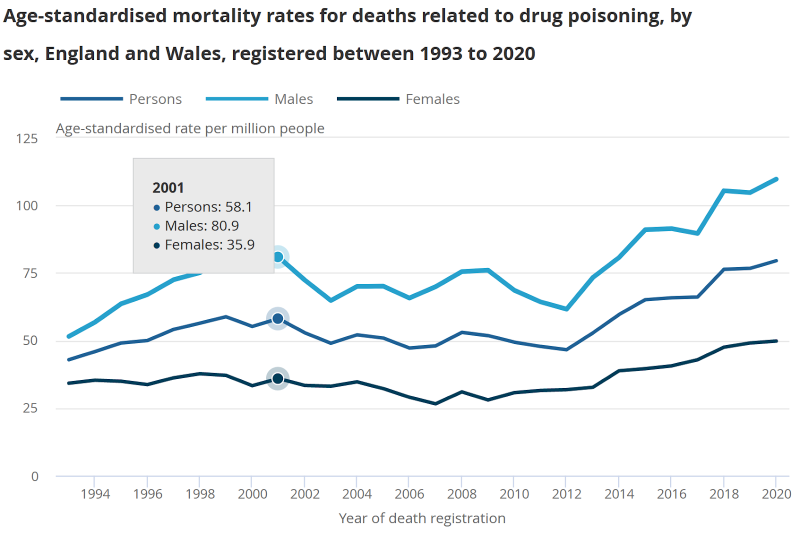
Around a 60% increase in drug poisoning deaths is evident since 2012, with the increase ongoing in 2020. Comparable data for 2021 is still coming, but we don’t hold high hopes for it. While European teenagers locked at home may have found it difficult to booze or get high around their parents, young people able to escape constant oversight can indulge a lot more, as for instance found among German university students during lockdowns.
Reflections
The West is raising a crippled generation. People born in the past 5 to 25 years are more obese, less intelligent, more depressed, less happy, more conflicted, more prone to drug abuse, less proud of their country, and less encouraged by the authorities than those born even 10 years prior. A monstrous generation, ideologically besieged by what external observers looking for our weaknesses call a ‘bizarre horde of savages,’ is currently being shaped by our schools, media, and propagandists. Our youth have been taught to hate themselves, their own culture, and their own history. Their weak intellectual ability means they will struggle to decipher what has happened to them or who they are. Relative to generations as recent as Generation X, our youth are unhealthy, anxious, socially shy, prone to flee towards online gaming and offline drugs, stuck in victimhood narratives, angry at the world, and lonely.
What is this crippled generation going to do once it gains adulthood and power? We know they will have low productivity, low social skills, and a poor understanding of the world. What about their hearts though – will they at least have humanity and compassion for their fellow man? Sadly, what we have taught them in this area leads us to predict that when the going gets tough, they are not going to blink twice about sending millions into death camps if their weak minds can be manipulated into thinking that doing so will save them. We are producing a Frankenstein generation.
Today’s children will be tomorrow’s monsters because our societies are raising them, right now, to be monsters. A generation taught to take pleasure in draconian, bureaucratic rules oriented toward face-saving, with no regard to victims. A generation used to propaganda and make-believe certainty. A generation blind to millions of deaths, whether at home or abroad. A truly frightening generation – not only crippled itself, but ready to cripple others – is on its way out of the blocks.
Our advice: Choose carefully where you live
We have teenage children of our own, as well as children in their 20s who are not far from the decision to have kids. Theirs is this generation of which we speak. What advice do we offer our kids?
The main advice we give them is to have their suitcases ready and be prepared to move to another country or region at short notice. Those of our family who live in America we advise not to raise a family in still-mad places like New York and California, but to move to Florida or another of the comparatively saner states. To those in Europe we recommend Switzerland, Denmark, and parts of Eastern Europe over the UK or the quickly deteriorating central-EU countries (France, Italy, Germany, the Netherlands, or Austria).
The systematic and state-sanctioned abuse of children now commonplace in much of the West is bad enough that, were we raising young families today, we would base our choices about where to live on the need to protect our children from this damage.
Of course, the option remains to stand and fight. In a supportive community that is aware of what is happening and has gelled around resistance to it, there is a chance. One can set up one’s own schools, play groups, clubs, media, and churches to try to fight the Frankensteining impulses in one’s backyard.
Yet no matter what they do, many parents simply cannot escape the general culture and political choices of their local context. On top of that, the internet, the government and social media will intrude anyway, no matter how remote the community. A caring parent can try to shield children where possible and push back through open, critical, loving dialogue in the home, but children are very sensitive to their peer groups and to social media, which are both sucked along with the spoutings of authorities and local moralists.
On balance, call us cowards, but we wouldn’t risk the continued abuse of our own kids. There will be enough Frankensteins already without adding our own progeny to that army. We would flee the madness and try to start a new life in the least crazy place we could find.
Deep hope
Could committed governments and repentant parents avert the disaster they are cooking up right now? Yes, to a large extent. The recipe is not even that difficult. The problem is that we see little chance that the key ingredient – a recognition of what they have done and are doing – will arrive, because it is too painful.
Continued child abuse is, unfortunately, a more psychologically comfortable option for the actors whose voice matters – i.e., the middle classes and above – than to admit to themselves what they have been part of. It is just not human to load the weight of that kind of horror onto oneself. Continuing the horror or muddling on while pretending it didn’t happen is much more appealing.
While we therefore expect populations and authorities to muddle on, dealing in a half-baked way with some of the worst problems as they manifest themselves, let us remember that good child-rearing recipes do exist.
One can shield children from mobile phones and social media until they are old enough to manage them with full awareness – say around age 15. One can abolish most forms of online learning and improve the quality of teachers. One can mass-organize positive activities, like frequent hugging, exercise, empathic skill training, and unstructured play, while imbuing children with positive history lessons, an affirming attitude toward local cultures, an aversion to applying medical solutions to social problems, and the importance of personal responsibility. Local communities can be encouraged, via social norms, to take up the role of providing pastoral care and broad civic education.
All this and much more could be done. It’s not that hard to work out what should be done, because educational and social communities in many Western countries have already figured out most of it. Child-rearing in the West functioned pretty well, on the back of such tactics, not so long ago. To the good examples set in the 1985-2010 era, one need only add modern knowledge of the effects of mobile phones, social media, and self-loathing ideologies.
Knowledge about how to raise a thriving generation, capable of navigating modern life, is available for the taking – whether now, in selected places by committed communities, or in the future. Not all children of the West will inevitably be crippled, and society does in the long run tend to follow good examples, so this horror cannot last forever. We have deep hope.